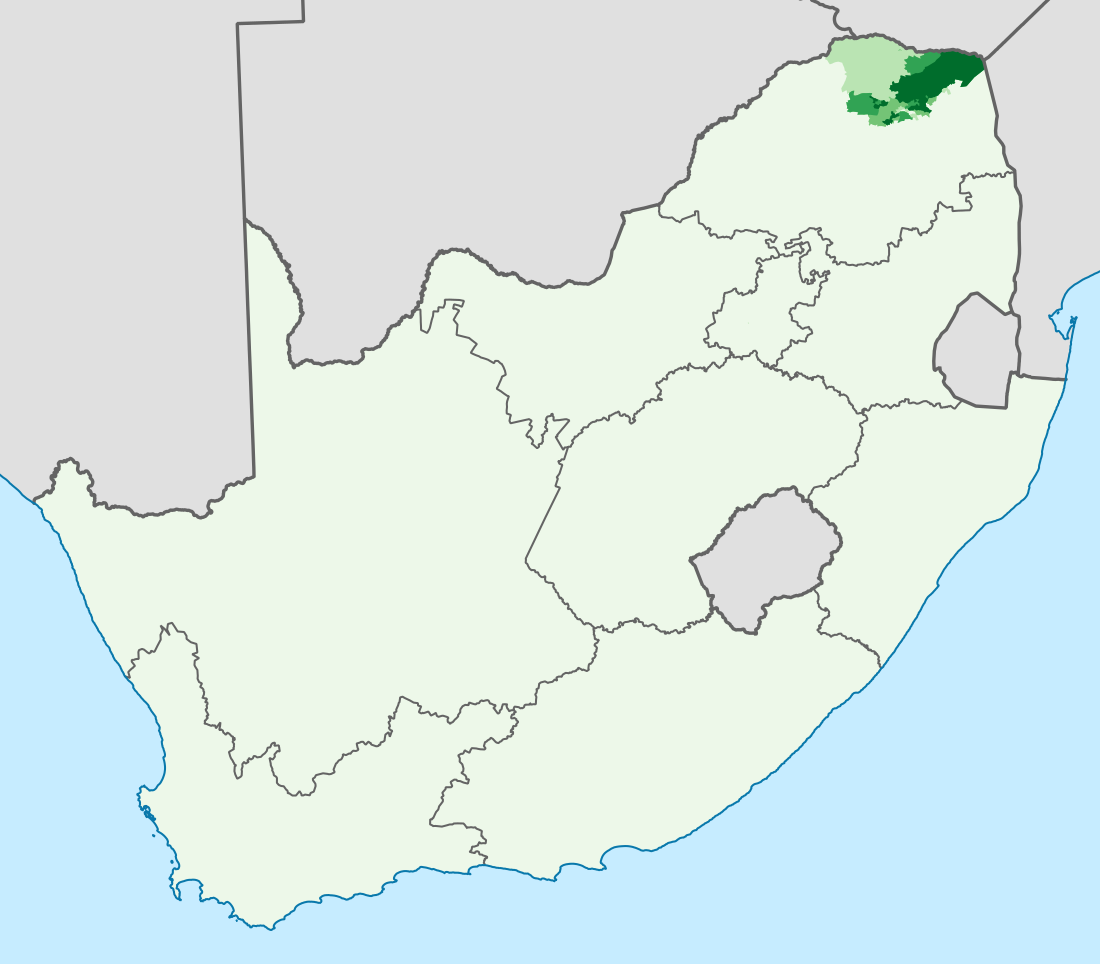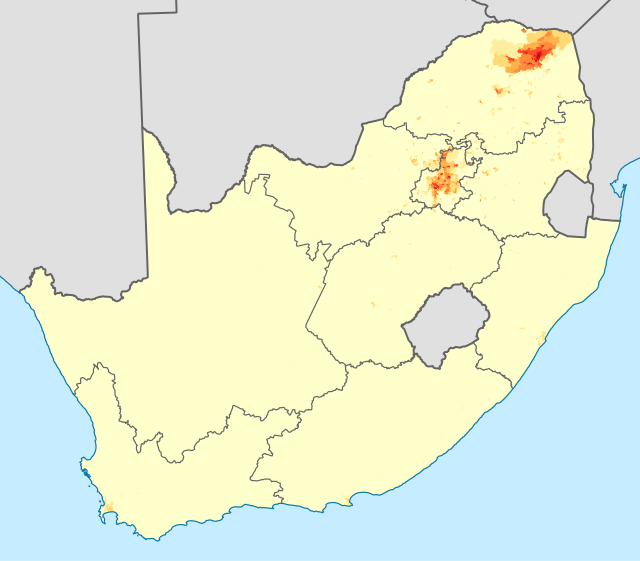Top Qs
Timeline
Chat
Perspective
Venda language
Bantu language of South Africa and Zimbabwe From Wikipedia, the free encyclopedia
Remove ads
Venḓa or Tshivenḓa is a Bantu language and an official language of South Africa and Zimbabwe. It is mainly spoken by the Venda people (or Vhavenḓa) in the northern part of South Africa's Limpopo province, as well as by some Lemba people in South Africa. The Tshivenda language is related to Shona (Karanga and Kalanga) which is spoken in Southern Africa. During the apartheid era of South Africa, the Bantustan of Venda was set up to cover the Venda speakers of South Africa.
According to the 2011 census, Venda speakers are concentrated in the following areas: Makhado Local Municipality, with 350,000 people; Thulamela Local Municipality, with 370,000 people; Musina Local Municipality, with 35,000 people; and Mutale Local Municipality, with 89,000 people. The total number of speakers in Vhembe district currently stands at 844,000. In Gauteng province, there are 275,000 Venda speakers. Fewer than 10,000 are spread across the rest of the country—for a total number of Venda speakers in South Africa at 1.2 million people or just 2.2% of South Africa's population, making Venda speakers the second smallest minority language in South Africa, after the Ndebele language, which number 1.1 million speakers. The population statistics of the Venda people in Zimbabwe are not clear but may currently stand at a million. The people are concentrated in the South of the country but also spread to other towns and cities. There is also a significant number of them in neighbouring South Africa where they are migrant workers.
Remove ads
Writing system
Summarize
Perspective
The Venda language uses the Latin alphabet with five additional accented letters. There are four dental consonants with a circumflex accent below the letter (ḓ, ḽ, ṋ, ṱ) and an overdot for velar ṅ. Five vowel letters are used to write seven vowels. The letters C, J and Q are used only for foreign words and names.
| A a | B b | (C c) | D d | Ḓ ḓ | E e | F f | G g | |
| H h | I i | (J j) | K k | L l | Ḽ ḽ | M m | N n | |
| Ṋ ṋ | Ṅ ṅ | O o | P p | (Q q) | R r | S s | T t | |
| Ṱ ṱ | U u | V v | W w | X x | Y y | Z z |
Unicode
The extra letters have the following Unicode names:
- Ḓ U+1E12 LATIN CAPITAL LETTER D WITH CIRCUMFLEX BELOW
- ḓ U+1E13 LATIN SMALL LETTER D WITH CIRCUMFLEX BELOW
- Ḽ U+1E3C LATIN CAPITAL LETTER L WITH CIRCUMFLEX BELOW
- ḽ U+1E3D LATIN SMALL LETTER L WITH CIRCUMFLEX BELOW
- Ṅ U+1E44 LATIN CAPITAL LETTER N WITH DOT ABOVE
- ṅ U+1E45 LATIN SMALL LETTER N WITH DOT ABOVE
- Ṋ U+1E4A LATIN CAPITAL LETTER N WITH CIRCUMFLEX BELOW
- ṋ U+1E4B LATIN SMALL LETTER N WITH CIRCUMFLEX BELOW
- Ṱ U+1E70 LATIN CAPITAL LETTER T WITH CIRCUMFLEX BELOW
- ṱ U+1E71 LATIN SMALL LETTER T WITH CIRCUMFLEX BELOW
Luṱhofunḓeraru lwa Mibvumo
This section may contain information not important or relevant to the article's subject. (July 2017) |
The sintu writing system Isibheqe Sohlamvu/Ditema tsa Dinoko, known technically in Venda as Luṱhofunḓeraru lwa Mibvumo, is also used for the Venda language.[citation needed]
Remove ads
Phonology
Summarize
Perspective
Venda distinguishes dental ṱ, ṱh, ḓ, ṋ, ḽ from alveolar t, th, d, n, l as well as (like in Ewe) labiodental f, v from bilabial fh, vh (the last two are slightly rounded). There are no clicks. As in other South African languages like Zulu, ph, ṱh, th, kh are aspirated and the "plain" stops p, ṱ, t, and k are ejective.[4]
Vowels
There are five vowel sounds in Tshivenḓa.
Consonants
A labiodental nasal /ɱ/ sound appears in prenasalised consonant sounds. [l] is mostly heard as an allophone of /ɺ/ in free variation and in loanwords. Labiovelar sounds occur as alternatives to labiopalatal sounds and may also be pronounced /pkʰ pkʼ bɡ mŋ/.[4] Fortition of /ɸ β s ʃ x h l̪ ɺ r w/ occurs after nasal prefixes, likely to [pʰ? b tsʰ tʃʰ kʰ? pʰ d̪ d d b].[5]
Tones
Venda has a specified tone, HIGH, with unmarked syllables having a low tone. Phonetic falling tone occurs only in sequences of more than one vowel or on the penultimate syllable if the vowel is long. Tone patterns exist independently of the consonants and vowels of a word and so they are word tones. Venda tone also follows Meeussen's rule: when a word beginning with a high tone is preceded by that high tone, the initial high tone is lost. (That is, there cannot be two adjacent marked high tones in a word, but high tone spreads allophonically to a following non-tonic ("low"-tone) syllable.) There are only a few tone patterns in Venda words (no tone, a single high tone on some syllable, two non-adjacent high tones), which behave as follows:
Remove ads
References
Sources
External links
Wikiwand - on
Seamless Wikipedia browsing. On steroids.
Remove ads




